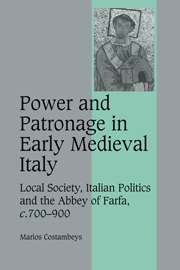 Power and Patronage in Early Medieval Italy
Power and Patronage in Early Medieval Italy Book contents
- Frontmatter
- Contents
- List of illustrations
- Acknowledgements
- Note on charter editions
- List of abbreviations
- Maps
- 1 INTRODUCTION
- 2 PATRONAGE AND LOMBARD RULERS
- 3 AUTHORITY, RULERSHIP AND THE ABBEY
- 4 THE MONKS AND ABBOTS OF FARFA: IDENTITIES AND AFFILIATIONS
- 5 SABINE LANDS AND LANDOWNERS
- 6 ELITE FAMILIES IN THE SABINA
- 7 FARFA AND ITALIAN POLITICS IN THE LOMBARD ERA
- 8 FARFA, ITALIAN POLITICS AND THE CAROLINGIANS
- Bibliography
- Index
- Cambridge Studies in Medieval Life and ThoughtFourth Series
4 - THE MONKS AND ABBOTS OF FARFA: IDENTITIES AND AFFILIATIONS
Published online by Cambridge University Press: 17 July 2009
- Frontmatter
- Contents
- List of illustrations
- Acknowledgements
- Note on charter editions
- List of abbreviations
- Maps
- 1 INTRODUCTION
- 2 PATRONAGE AND LOMBARD RULERS
- 3 AUTHORITY, RULERSHIP AND THE ABBEY
- 4 THE MONKS AND ABBOTS OF FARFA: IDENTITIES AND AFFILIATIONS
- 5 SABINE LANDS AND LANDOWNERS
- 6 ELITE FAMILIES IN THE SABINA
- 7 FARFA AND ITALIAN POLITICS IN THE LOMBARD ERA
- 8 FARFA, ITALIAN POLITICS AND THE CAROLINGIANS
- Bibliography
- Index
- Cambridge Studies in Medieval Life and ThoughtFourth Series
Summary
THE BACKGROUNDS OF THE MONKS
The abbey of Farfa was no faceless institution, remote from the social environment of its region. Patronage of the abbey entailed movements not only of the tenure of property, but also of people, in the form of oblations. These movements created and enhanced personal relations between the abbey and its patrons, cementing bonds that inevitably conditioned the political stances of both. What these stances were, and how they had an impact upon the wider world, will be assessed at the end of this chapter. First, however, it is necessary to be clearer about the intimacy of the link between the Farfa community and the laity of the Sabina. Here we can redress an imbalance in the historiography, for while it has been noted that some Farfa monks hailed from beyond the Sabina, the extent and importance of the abbey's recruitment within the Sabina has rarely been appreciated. More often stressed is the apparently Frankish origin of some of the monks and a number of the abbots: we shall examine the latter's identities shortly.
The insinuation of Farfa into the secular world around it is of course clearest when members of that local society became monks at the abbey. Farfa was, after all, but a community of individuals, each with their own background and interests. How Farfa's agenda and policies were formulated is a question that cannot be answered directly: we know nothing about the mechanisms of organization within the abbey.
- Type
- Chapter
- Information
- Power and Patronage in Early Medieval ItalyLocal Society, Italian Politics and the Abbey of Farfa, c.700–900, pp. 133 - 163Publisher: Cambridge University PressPrint publication year: 2007
